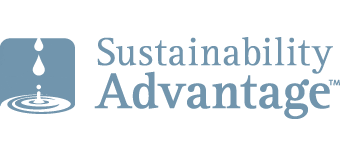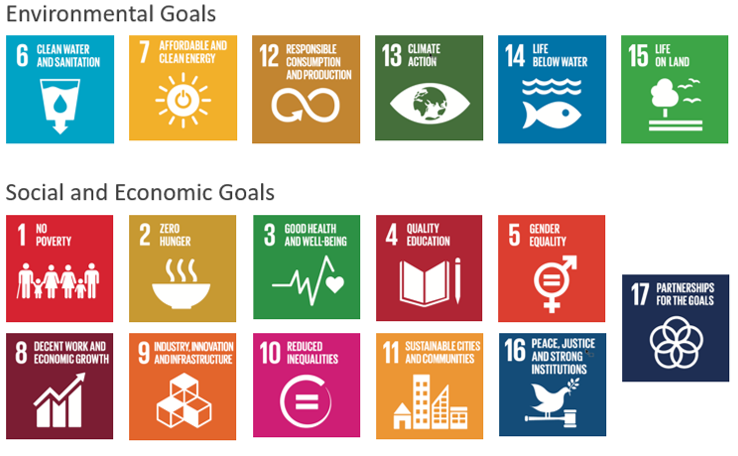7 Ways Companies Can Contribute to the SDGs
The Sustainable Development Goals (SDGs), a.k.a. the Global Goals, are increasingly embraced by companies as a useful reporting framework for their sustainability efforts. That’s a good thing. However, many companies focus on how they directly contribute to only three to five SDGs that are deemed to be most relevant to their business models and ignore the rest. They seriously undervalue their investments in social and environmental wellbeing. It’s time that they gave a more comprehensive and transparent account of the seven ways that they directly or indirectly create natural, human and social capital, as framed by the SDGs.
Flourishing societies enable flourishing businesses. Achievement of the SDGs creates an arena of thriving stakeholders on which companies depend for their success. The environment is the holding company for society and businesses. There are signs that the holding company is struggling to stay in business. It needs its societal and business subsidiaries’ help to protect and restore its 21 vital ecosystem services, especially to address the crisis of its destabilized climate regulation service. The SDGs define the end state for a resilient and sustainable environment that supports a resilient and just society, that fosters a resilient and inclusive economy. There is $12 trillion in potential economic growth linked to achieving the SDGs. It’s in the self-interest of companies to contribute to them. Here are seven ways they can do that.
- Invest in governments: pay right taxes
At first glance, most of the SDGs look like they are governments’ business more that companies’ business – protect the environment, provide quality education, ensure comprehensive health care, build sustainable communities and so on. But governments are financially starved by tricky tax avoidance schemes or tax breaks used to lure businesses into their jurisdictions. Tax avoidance is legal but it has grown to unethical proportions. Too many companies are free-riders, enjoying essential physical and social infrastructure but not paying their fair share of the bill.Paying the right tax in the right jurisdiction at the right time is not a “burden” to be cleverly avoided; it is an investment. The return on that investment is a healthy, resilient society in which to conduct business. Corporate citizens should rightly include the amount of income and property taxes, minus any government subsidies or special incentives, in their accounting for how much they indirectly contribute toward SDG-framed environmental and social good. In the spirit of SDG #17: Partnerships for the Goals, companies use their taxes to partner with governments to enable all the SDGs. For most companies, this could be their most significant contribution to the SDGs. It should be celebrated with pride.
- Lobby for action on the SDGs
Rightly or wrongly, corporations have enormous influence on the political process, government policies and politicians. When we think of corporate lobbying, we may think of the National Rifle Association (NRA) and fossil fuel sector lobbying for self-serving, anti-SDG policies and laxer regulations. However, many companies band together to lobby in support of SDG-aligned policies.For example, Ceres and the We Mean Business coalition lobby for policies that accelerate the transition to a low-carbon economy (SDG #13: Climate Action), despite the Trump administration’s shameful withdrawal from the Paris Agreement. Companies can also support the election of politicians with platforms that are SDG-friendly like the comprehensive Green New Deal which ingeniously supports all the SDGs.
- Invest in SDG-friendly companies
Big financial asset management firms like Blackrock, Vanguard, and State Street manage trillions of dollars of investments in companies. Banks invest depositors’ funds, insurance companies invest policy holder premiums, and pension fund managers invest member contributions. And corporations themselves invest their unallocated capital reserves as a smarter way to manage them than sticking them under the CFO’s mattress. Imagine the boost to SDG progress if all these organizations – investment management firm, banks, insurance companies, pension fund managers and individual corporations — used an SDG-performance screen on the companies in which they invest.This is about more than divesting fossil fuel-related financial assets. It is harnessing proactive sustainable finance in support of companies leading the way to a low-carbon, SDG-compliant economy. Why do investors care? Because they are uneasy about company exposure to social unrest and climate change impacts. Bad actors could be a risky investment. Plus, there is evidence that companies having a good track record on sustainability issues like climate change outperform SDG-screened investments are safer, yield higher returns and renew a company’s social licence to operate. What’s not to like?
- Adopt SDG-impactful business models
Purpose-driven “impact business models” enable companies to create environmental and social value through their restorative operational practices, their products and services that help others contribute to the SDGs, their inclusive employment practices and other positive pursuits.For example, they may manufacture or install solar panels that help organizations reduce their carbon footprints in support of SDG # 7: Affordable and Clean Energy and SDG #13: Climate Action. Or they might support SDG #1: No Poverty by using fair-trade supply chains that provide decent work (SDG #8) for under-served populations. Or banks can give preferential rates to corporate borrowers who commit to the SDGs. Companies deserve credit for these kinds of high leverage contributions to progress on the SDGs. They’ll only get credit if they disclose them. .
- Commit to SDG-compliant procurement criteria
One of the biggest untapped accelerators on our SDG journey is sustainable, SDG-compliant procurement. Public and private sector organizations could create a massive ripple effect by simply purchasing from vendors with the best track record on SDG support. If the purchasing department weighs suppliers’ SDG scores high enough to matter when assessing bids, magic will happen. Suddenly all company’s will scramble to more compellingly and comprehensively describe, quantify and improve their efforts to support the SDGs.SDG-compliant procurement is a market force that would drive company SDG efforts more dramatically than any regulatory force. When companies discover that customers are requiring them to disclose how much they are supporting SDGs, suddenly they will be incented to show that they are at least doing more than their competitors. Perfect.
- Walk the talk on the SDGs
Companies can be transparent about how their current business model is potentially undermining or constraining delivery on the goals. They may be having counterproductive impacts on the SDGs and can contribute to the SDGs by reducing their negative impacts. These are usually highlighted in sustainability reports accompanied by trend lines to show continuous progress on not hindering the SDGs.For example, a company can reduce its harmful carbon footprint in support of SDG #13: Climate Action. It can increase the number of female employees, managers, executive and board members in support of SDG # 4: Gender Equality. It can pay living wages to more employees to at least break even on SDG #1: No Poverty, SDG #2: Zero Hunger, SDG #4: Quality Education and SDG # 8: Decent Work and Economic Growth. These are important contributions to the SDGs and provide a foundation of credibility that proves the company is really serious about supporting them.
- Invest in NGOs: practice strategic philanthropy
We mentioned earlier that the SDGs may look like they are governments’ business more that businesses’ business. They also may be perceived as the purview of non-governmental organizations (NGOs) more than companies. Companies may make monetary and in-kind strategic philanthropic donations to organizations like the Red Cross or the United Way which do good work on multiple SDGs. Companies may also support non-profits that focus on specific SDG areas, like Doctors Without Borders that help with SDG #3: Good Health and Wellbeing or 350.org that focuses on SDG #13: Climate Action. Some companies partner with NGOs on specific projects that have positive environmental or social impacts in SDG-relevant areas.Some NGOs are charities and provide tax receipts for donations; others don’t. Regardless, companies should proudly total up the monetary value of all their investments in NGO efforts to create environmental and social value that aligns with the SDGs, as well as cite the scale, depth and duration of specific projects that they undertake with NGOs partners. Companies protect their social licence when they publicly acknowledge and quantify these high-leverage direct and indirect contributions to the achievement of SDGs.
The SDGs have broken into the mainstream of business reporting: 72% of global companies now mention the goals in their annual corporate or sustainability report and 50% of companies have identified priority SDGs. The top three SDGs that companies mention in their reports are SDG #8: Decent Work and Economic Growth, SDG #13: Climate Action and SDG #12: Responsible Consumption and Production. The least frequently mentioned are SDG#1: No Poverty, SDG #2: Zero Hunger and SDG #14: Life Below Water. Companies are being way too modest. They risk accusations of “SDG-washing” if they don’t tell a more comprehensive story about how they contribute to individual and collective SDGs in the above seven ways.
As companies go public about how they are leading by example, momentum will build and the odds of us meeting the 17 SDGs by 2030 will improve exponentially. Who knows? With impactful corporate leadership, contributions and partnerships for the goals, we may be able to accomplish the goals in time.
Please feel free to add your comments and questions using the “Leave a reply” comment box under the “Share this entry” social media symbols, below. For email subscribers, please click here to visit my site and provide feedback.




